Coupled Thermal-Hydraulic-Mechanical Modeling of Near-Well Stress Evolution in Naturally Fractured Formations during Drilling
Abstract
:1. Introduction
2. Methodology
2.1. Governing Equations
2.2. Limitations and Assumptions
3. Results and Discussion
3.1. Base Case
3.2. Effect of Pressure on the Wellbore Wall
3.3. Effect of Internal Friction Angle
3.4. Effect of Natural Fracture Length
3.5. Discussion
4. Conclusions
- (1)
- The temporal and spatial evolution patterns of pressure near the wellbore are more sensitive to the existence of natural fractures than those of temperature. Natural fractures only facilitate fluid flow.
- (2)
- Natural fractures cause heterogeneous geo-mechanical responses. However, the general wellbore failure patterns still follow the analytical solutions.
- (3)
- Wellbore failure risks are highly sensitive to the internal friction angle of the formation. Natural fracture length also governs the near-well failure risks. Longer natural fractures increase the failure index values and the area with high failure risks.
- (4)
- It is important to characterize the internal friction angle and the geometry of natural fractures for the optimization of drilling parameters in naturally fractured formations. Improving the quantification quality of these parameters before drilling can effectively reduce formation failure risks.
Author Contributions
Funding
Data Availability Statement
Acknowledgments
Conflicts of Interest
References
- Weng, X. Modeling of complex hydraulic fractures in naturally fractured formation. J. Unconv. Oil Gas Resour. 2015, 9, 114–135. [Google Scholar] [CrossRef]
- He, Y.; Qiao, Y.; Qin, J.; Tang, Y.; Wang, Y.; Chai, Z. A novel method to enhance oil recovery by inter-fracture injection and production through the same multi-fractured horizontal well. J. Energy Resour. Technol. 2022, 144, 043005. [Google Scholar] [CrossRef]
- Zhao, X.; Jin, F.; Liu, X.; Zhang, Z.; Cong, Z.; Li, Z.; Tang, J. Numerical study of fracture dynamics in different shale fabric facies by integrating machine learning and 3-D lattice method: A case from Cangdong Sag, Bohai Bay basin, China. J. Pet. Sci. Eng. 2022, 218, 110861. [Google Scholar] [CrossRef]
- Li, Q.; Wu, J. Factors affecting the lower limit of the safe mud weight window for drilling operation in hydrate-bearing sediments in the Northern South China Sea. Geomech. Geophys. Geo-Energy Geo-Resour. 2022, 8, 82. [Google Scholar] [CrossRef]
- Li, Q.; Wang, F.; Wang, Y.; Zhou, C.; Chen, J.; Forson, K.; Miao, R.; Su, Y.; Zhang, J. Effect of reservoir characteristics and chemicals on filtration property of water-based drilling fluid in unconventional reservoir and mechanism disclosure. Environ. Sci. Pollut. Res. 2023, 30, 55034–55043. [Google Scholar] [CrossRef]
- Guo, X.; Jin, Y.; Zi, J.; Lin, J.; Zhu, B.; Wen, Q.; Jing, Q. Numerical Investigation of Depressurization through Horizontal Wells in Methane-Hydrate-Bearing Sediments Considering Sand Production. J. Mar. Sci. Eng. 2022, 10, 1777. [Google Scholar] [CrossRef]
- Fekete, P.; Bruno, L.A.; Dosunmu, A.; Odagme, S.; Sanusi, A.; Bowe, E. The effect of wellbore stability in naturally fractured reservoirs. In Proceedings of the SPE Nigeria Annual International Conference and Exhibition, Lagos, Nigeria, 4–6 August 2015; OnePetro: Richardson, TX, USA, 2015. [Google Scholar]
- Gao, J.; Lin, H.; Wu, B.; Deng, J.; Liu, H. Porochemothermoelastic solutions considering fully coupled thermo-hydro-mechanical-chemical processes to analyze the stability of inclined boreholes in chemically active porous media. Comput. Geotech. 2021, 134, 104019. [Google Scholar] [CrossRef]
- Zhi, D.; Guo, X.; Wang, W.; Jin, Y.; Liu, C.; Chen, G.; Wang, Z. Fracturing and production analysis of the efficacy of hydraulic fracture stage reduction in the improvement of cost-effectiveness in shale oil development: A case study of Jimsar shale oil, China. Energy Sci. Eng. 2021, 9, 1337–1348. [Google Scholar] [CrossRef]
- Wang, H.M.; Towler, B.F.; Soliman, M.Y. Near-wellbore stress analysis and wellbore strengthening for drilling depleted formations. In Proceedings of the Rocky Mountain Oil & Gas Technology Symposium, Denver, CO, USA, 16–18 April 2007; OnePetro: Richardson, TX, USA, 2007. [Google Scholar]
- Wang, H.M.; Towler, B.F.; Soliman, M. Fractured wellbore stress analysis: Sealing cracks to strengthen a wellbore. In Proceedings of the SPE/IADC Drilling Conference, Amsterdam, The Netherlands, 20–22 February 2007; OnePetro: Richardson, TX, USA, 2007. [Google Scholar]
- Helstrup, O.A.; Chen, Z.; Rahman, S.S. Time-dependent wellbore instability and ballooning in naturally fractured formations. J. Pet. Sci. Eng. 2004, 43, 113–128. [Google Scholar] [CrossRef]
- Barton, C.A.; Zoback, M.D. Discrimination of natural fractures from drilling-induced wellbore failures in wellbore image data—Implications for reservoir permeability. SPE Reserv. Eval. Eng. 2002, 5, 249–254. [Google Scholar] [CrossRef]
- Kidambi, T.; Kumar, G.S. Mechanical earth modeling for a vertical well drilled in a naturally fractured tight carbonate gas reservoir in the Persian Gulf. J. Pet. Sci. Eng. 2016, 141, 38–51. [Google Scholar] [CrossRef]
- Feng, Y.; Gray, K.E. A fracture-mechanics-based model for wellbore strengthening applications. J. Nat. Gas Sci. Eng. 2016, 29, 392–400. [Google Scholar] [CrossRef]
- Han, Y.; Liu, C.; Phan, D.; AlRuwaili, K.; Abousleiman, Y. Advanced wellbore stability analysis for drilling naturally fractured rocks. In Proceedings of the SPE Middle East Oil and Gas Show and Conference, Manama, Bahrain, 19–21 March 2019; OnePetro: Richardson, TX, USA, 2019. [Google Scholar]
- Bagdeli, M.; Manshad, A.K.; Shadizadeh, S.R.; Ali, J.A.; Gholami, R.; Keshavarz, A.; Iglauer, S. Natural fracture characterization and wellbore stability analysis of a highly fractured southwestern Iranian oilfield. Int. J. Rock Mech. Min. Sci. 2019, 123, 104101. [Google Scholar] [CrossRef]
- Meng, M.; Baldino, S.; Miska, S.Z.; Takach, N. Wellbore stability in naturally fractured formations featuring dual-porosity/single-permeability and finite radial fluid discharge. J. Pet. Sci. Eng. 2019, 174, 790–803. [Google Scholar] [CrossRef]
- Chen, B.; Ji, J.; Lin, J.; Chen, H.; Wang, X.; Guo, X.; Yang, W.; Lin, J. Experimental and numerical investigation of characteristics of highly heterogeneous rock mechanical responses in tight sandy conglomerate reservoir rock under tri-axial compression. Front. Earth Sci. 2021, 9, 735208. [Google Scholar] [CrossRef]
- Wang, L.; Li, Y.; Xu, D.; Gao, Y.; Zhang, J.; He, J.; Zhang, F.; Gao, S.; Guo, X. Evolution of Near-Well Damage Caused by Fluid Injection through Perforations in Wellbores in Low-Permeability Reservoirs: A Case Study in a Shale Oil Reservoir. Lithosphere 2022, 2022, 3824011. [Google Scholar] [CrossRef]
- Coussy, O. Poromechanics; John Wiley & Sons: Hoboken, NJ, USA, 2004. [Google Scholar]
- Roussel, N.P.; Florez, H.A.; Rodriguez, A.A. Hydraulic fracture propagation from infill horizontal wells. In Proceedings of the SPE Annual Technical Conference and Exhibition, New Orleans, LA, USA, 30 September–1 October 2013; OnePetro: Richardson, TX, USA, 2013. [Google Scholar]
- Guo, X.; Song, H.; Killough, J.; Du, L.; Sun, P. Numerical investigation of the efficiency of emission reduction and heat extraction in a sedimentary geothermal reservoir: A case study of the Daming geothermal field in China. Environ. Sci. Pollut. Res. 2018, 25, 4690–4706. [Google Scholar] [CrossRef]
- Guo, X.; Jin, Y.; Zi, J.; Lin, B. Numerical investigation of the gas production efficiency and induced geomechanical responses in marine methane hydrate-bearing sediments exploited by depressurization through hydraulic fractures. Energy Fuels 2021, 35, 18441–18458. [Google Scholar] [CrossRef]
- Dean, R.H.; Gai, X.; Stone, C.M.; Minkoff, S.E. A comparison of techniques for coupling porous flow and geomechanics. SPE J. 2006, 11, 132–140. [Google Scholar] [CrossRef]
- Kim, J.; Moridis, G.J.; Yang, D.; Rutqvist, J. Numerical studies on two-way coupled fluid flow and geomechanics in hydrate deposits. SPE J. 2012, 17, 485–501. [Google Scholar] [CrossRef] [Green Version]
- Cheng, W.; Jiang, G.; Li, X.; Zhou, Z.; Wei, Z. A porochemothermoelastic coupling model for continental shale wellbore stability and a case analysis. J. Pet. Sci. Eng. 2019, 182, 106265. [Google Scholar] [CrossRef]
- Fan, X.; Zhang, M.; Zhang, Q.; Zhao, P.; Yao, B.; Lv, D. Wellbore stability and failure regions analysis of shale formation accounting for weak bedding planes in ordos basin. J. Nat. Gas Sci. Eng. 2020, 77, 103258. [Google Scholar] [CrossRef]
- Yang, D. A Simulator with Numerical Upscaling for the Analysis of Coupled Multiphase Flow and Geomechanics in Heterogeneous and Deformable Porous and Fractured Media. Ph.D. Dissertation, Texas A&M University, College Station, TX, USA, 2013. [Google Scholar]
- Yang, D.; Moridis, G.J.; Blasingame, T.A. A fully coupled multiphase flow and geomechanics solver for highly heterogeneous porous media. J. Comput. Appl. Math. 2014, 270, 417–432. [Google Scholar] [CrossRef]
- Kolditz, O.; Shao, H.; Wang, W.; Bauer, S. Thermo-Hydro-Mechanical Chemical Processes in Fractured Porous Media: Modelling and Benchmarking; Springer: Berlin/Heidelberg, Germany, 2016; Volume 25. [Google Scholar]
- Guo, T.; Zhang, Y.; Zhang, W.; Niu, B.; He, J.; Chen, M.; Yu, Y.; Xiao, B.; Xu, R. Numerical simulation of geothermal energy productivity considering the evolution of permeability in various fractures. Appl. Therm. Eng. 2022, 201, 117756. [Google Scholar] [CrossRef]
- Guo, X.; Jin, Y.; Zi, J.; Lin, J.; Zhu, B. A 3D modeling study of effects of heterogeneity on system responses in methane hydrate reservoirs with horizontal well depressurization. Gas Sci. Eng. 2023, 115, 205001. [Google Scholar] [CrossRef]
- Amestoy, P.R.; Duff, I.S.; L’Excellent, J.Y.; Koster, J. A fully asynchronous multifrontal solver using distributed dynamic scheduling. SIAM J. Matrix Anal. Appl. 2001, 23, 15–41. [Google Scholar] [CrossRef] [Green Version]
- Liang, C.; Xie, J.; Chen, Y.; Liu, J.; He, Y.; Zhao, J.; Wang, W.; Wang, L. Genesis and Coupling Relationship of Fractures in Shale Reservoir of Lucaogou Formation in Jimsar Sag, Junggar Basin. Xinjiang Pet. Geol. 2021, 42, 521–528. [Google Scholar]
- Liu, X.; Wang, X.; Zhao, B.; Xiong, J.; Liang, L. Propagation of Hydraulic Fractures and Fracability Evaluation of Sandy Conglomerate Reservoirs. Xinjiang Pet. Geol. 2023, 44, 169–177. [Google Scholar]
- Okubo, K.; Rougier, E.; Lei, Z.; Bhat, H.S. Modeling earthquakes with off-fault damage using the combined finite-discrete element method. Comp. Part. Mech. 2020, 7, 1057–1072. [Google Scholar] [CrossRef]

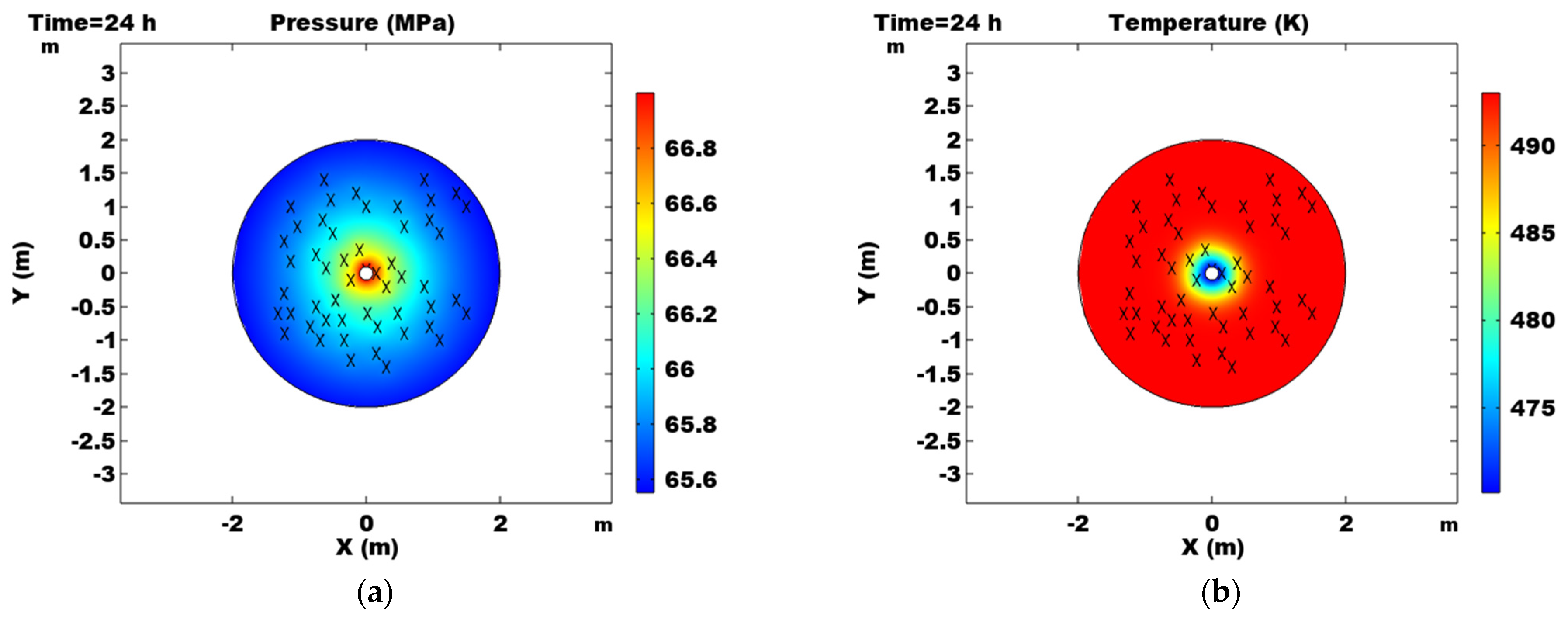

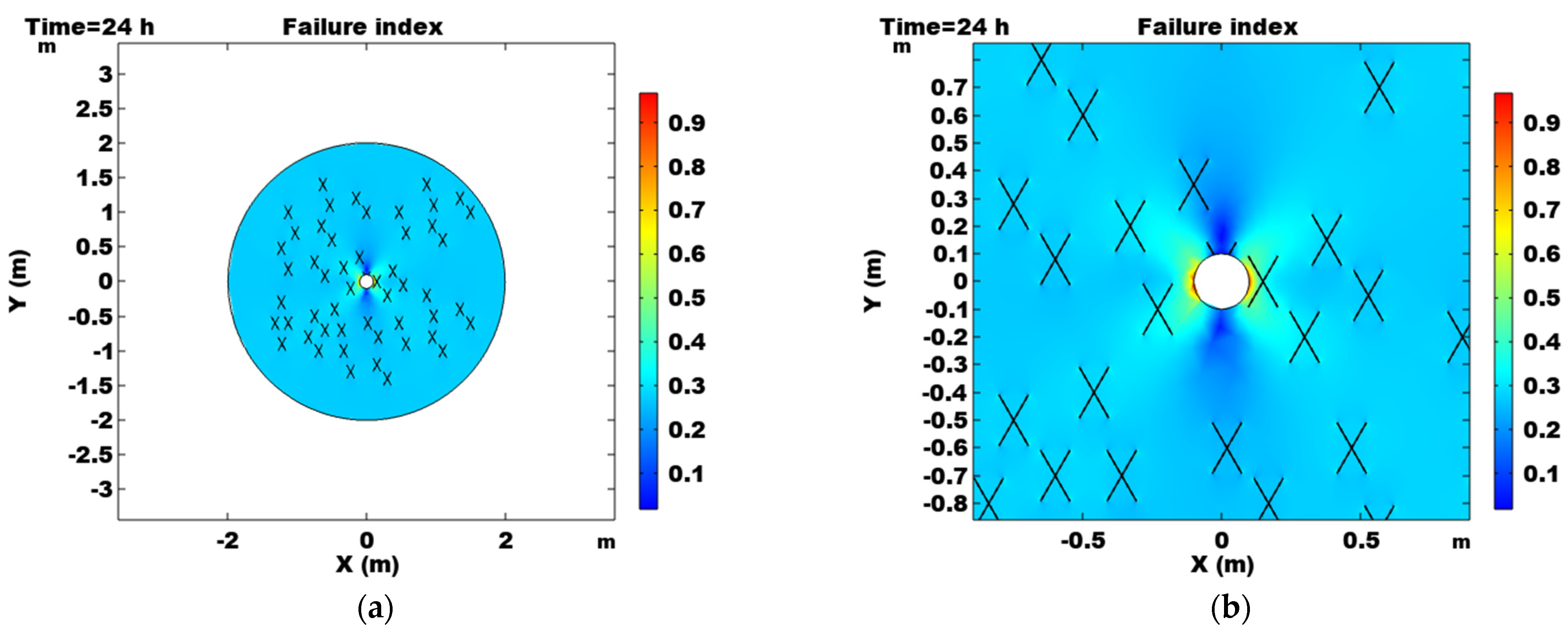

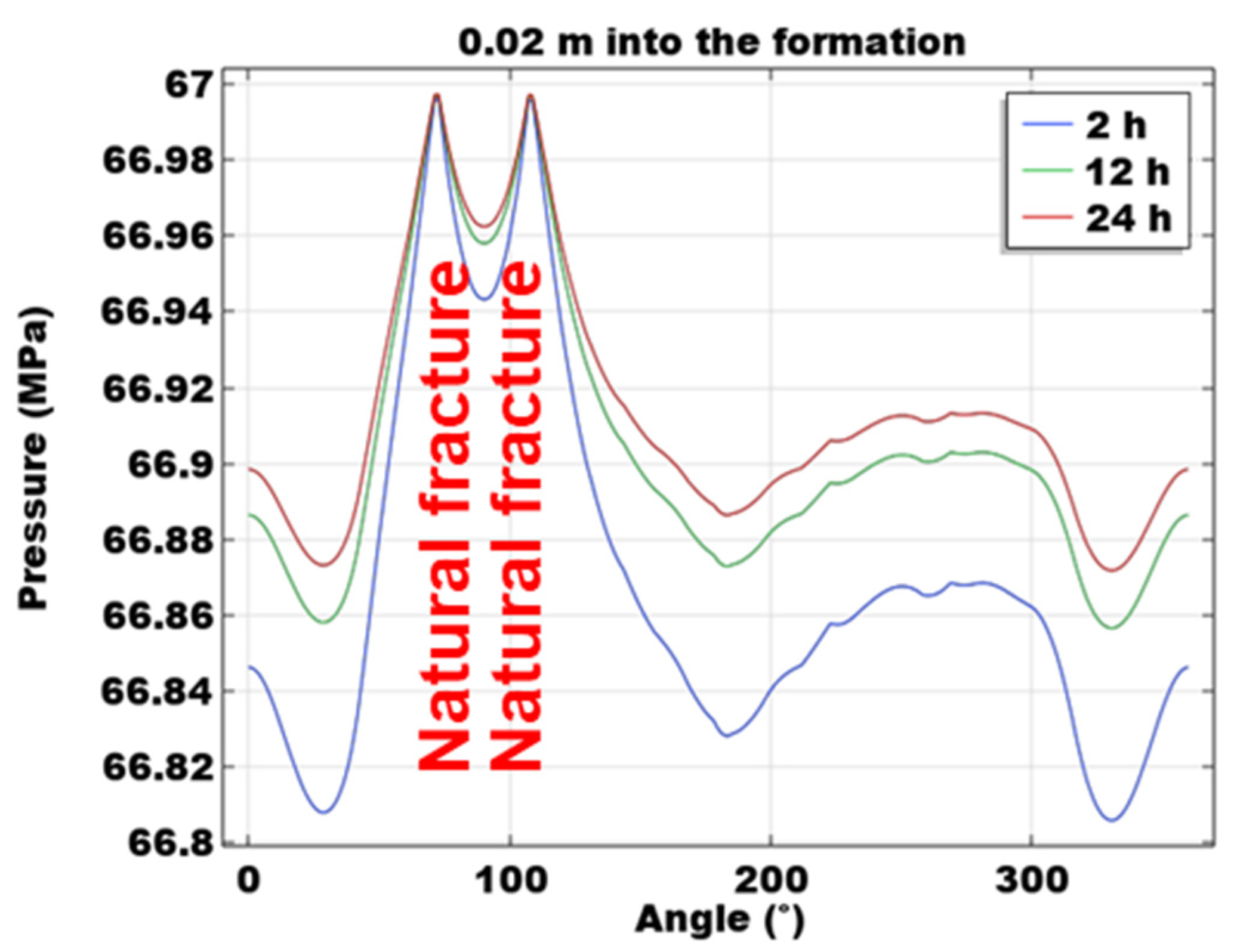

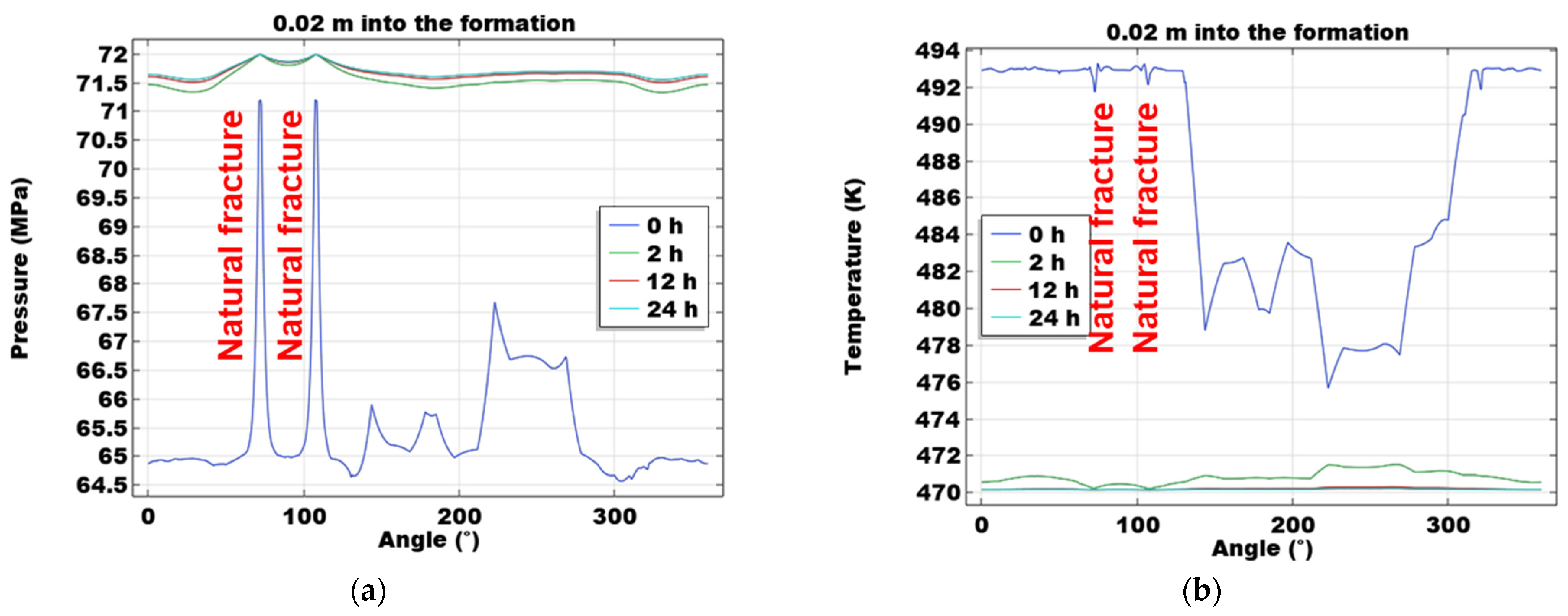
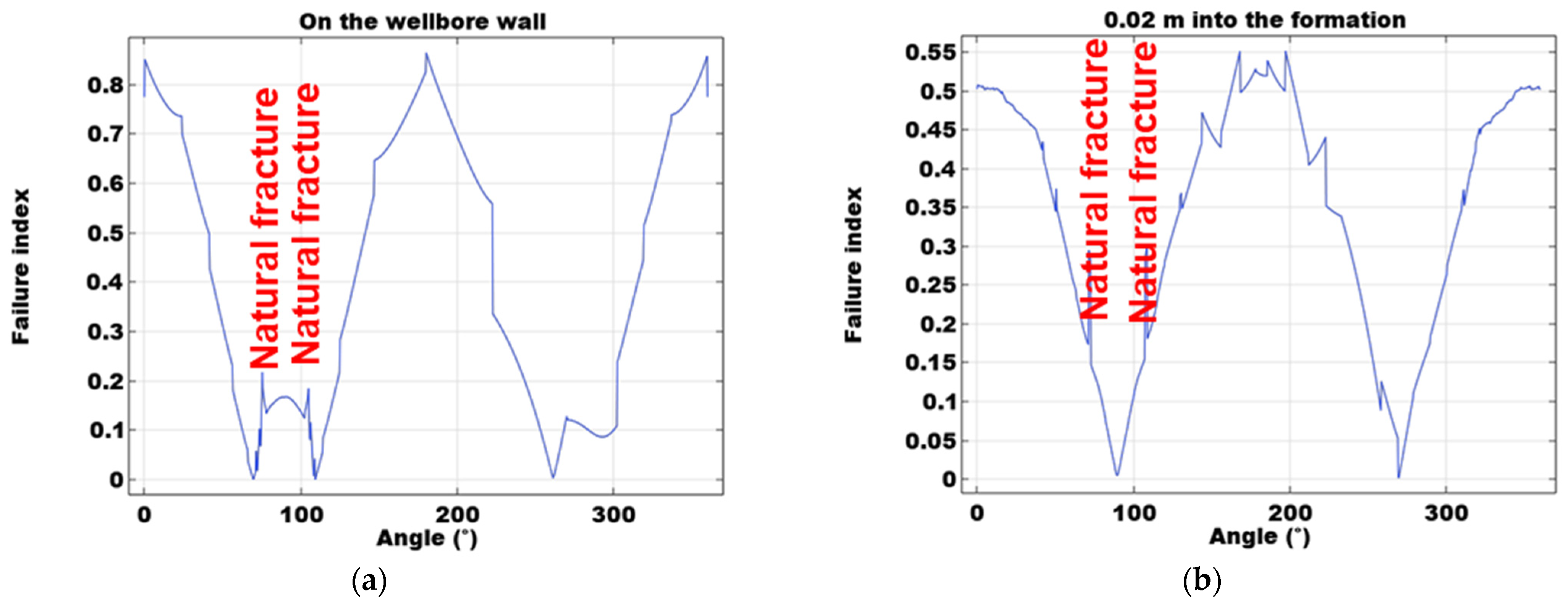


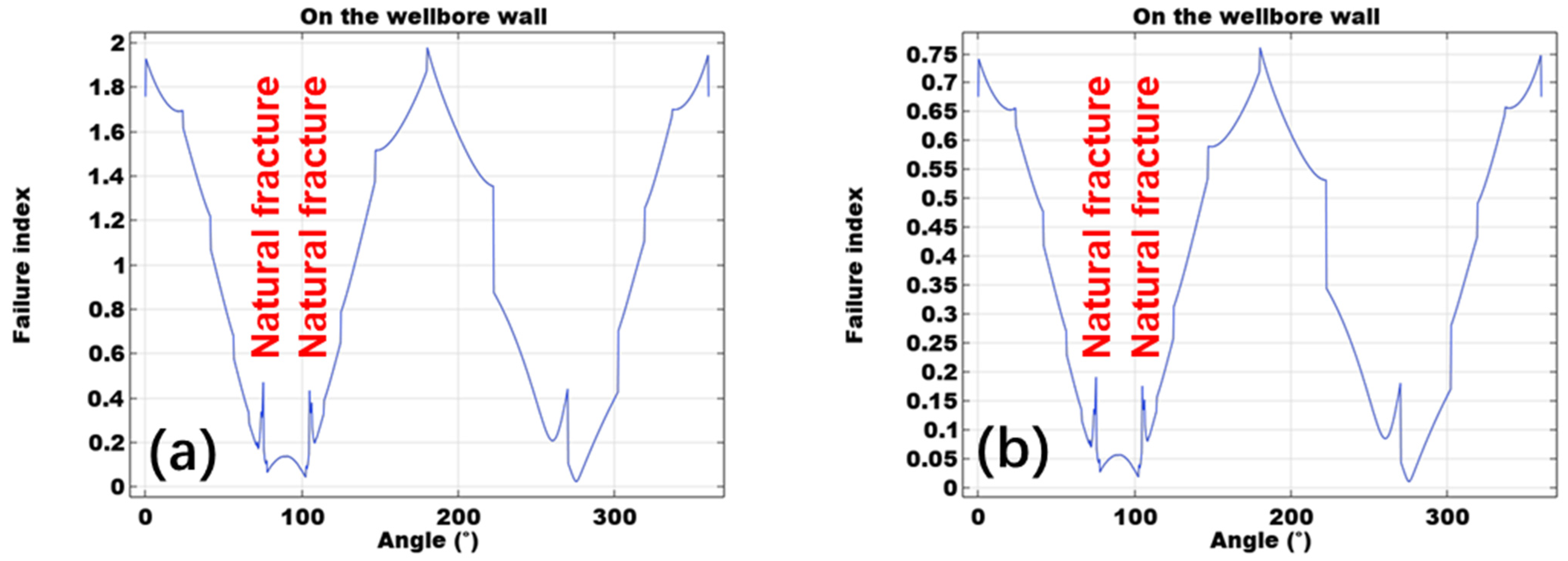
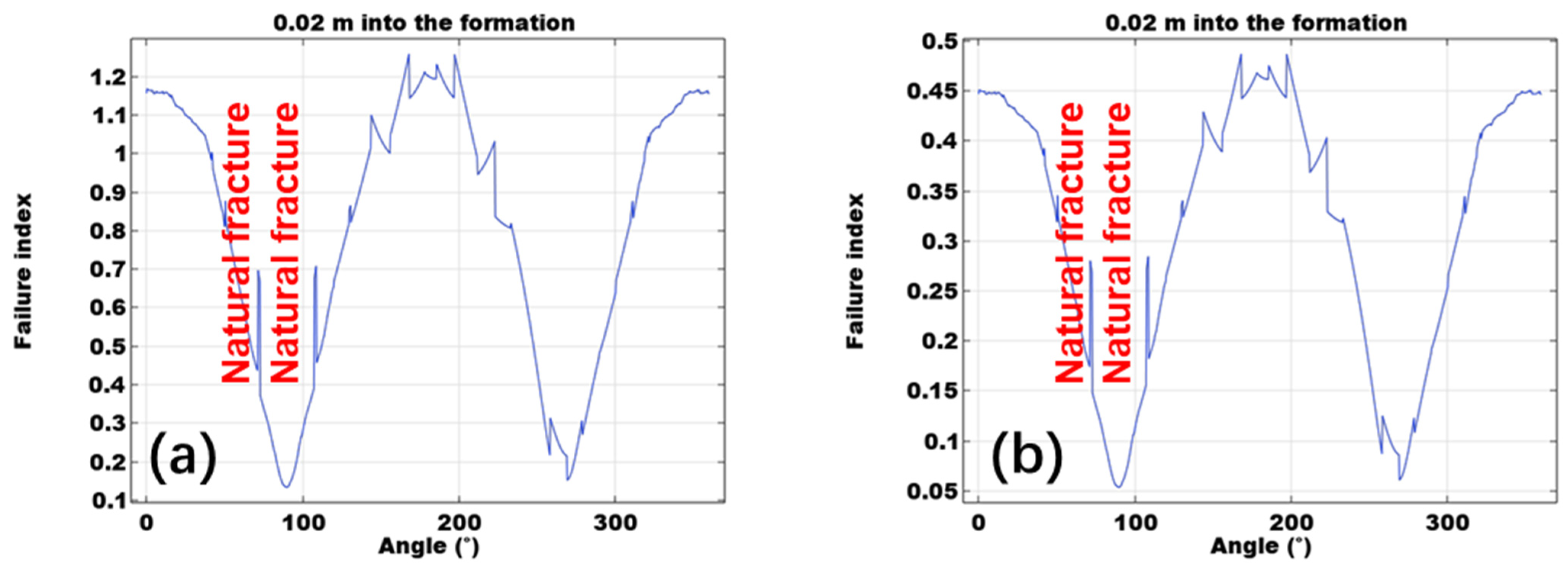
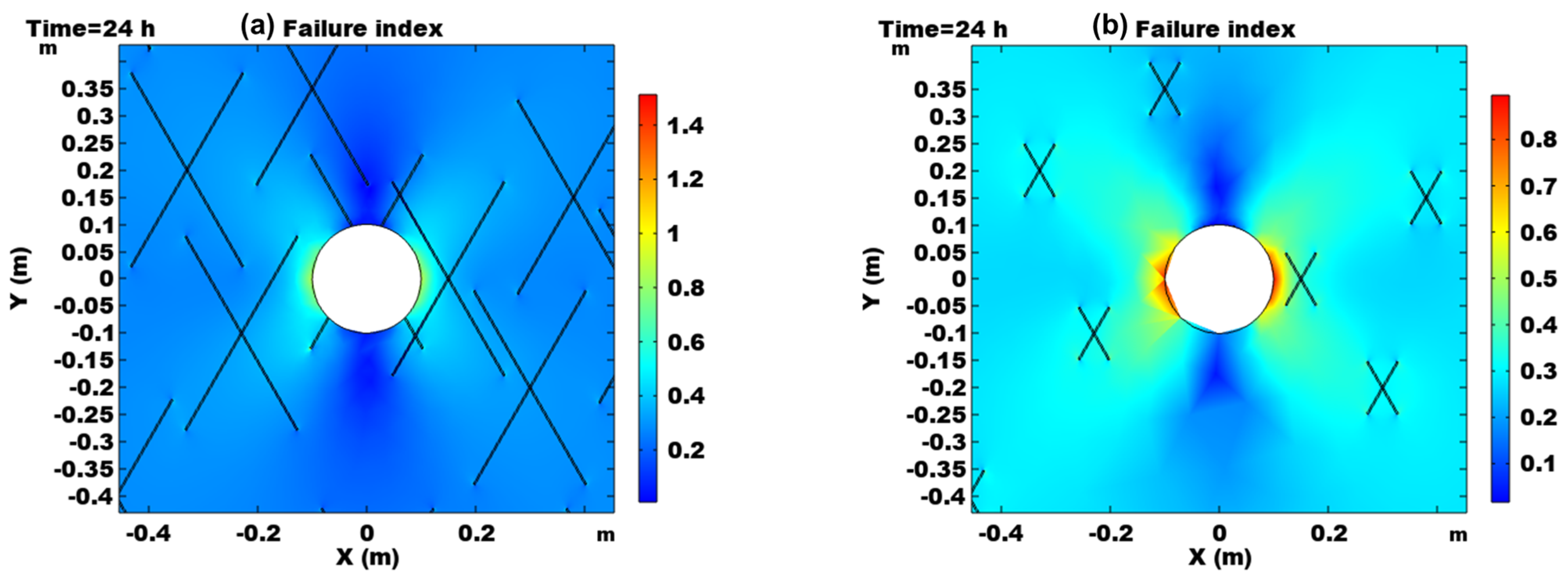
| Parameter | Value |
|---|---|
| Natural fracture width | 0.003 m |
| Natural fracture length | 0.21 m |
| Conjugate angle of natural fractures | 60° |
| Wellbore radius | 0.1 m |
| Young’s modulus of the matrix | 40 GPa |
| Poisson’s ratio of the matrix | 0.2 |
| Rock matrix density | 2600 kg/m3 |
| Biot’s coefficient | 1.0 |
| Maximum horizontal principal stress | 95 MPa |
| Minimum horizontal principal stress | 75 MPa |
| Overburden stress | 90 MPa |
| Reservoir fluid density | 1000 kg/m3 |
| Viscosity | 1 mPa·s |
| Rock matrix permeability | 1 mD |
| Reservoir pressure | 65 MPa |
| Porosity | 0.1 |
| Natural fracture permeability | 1000 mD |
| Reservoir temperature | 493 K |
| Reservoir fluid thermal conductivity | 0.598 W/(m·K) |
| Reservoir fluid heat capacity | 4184 J/(kg·K) |
| Rock thermal conductivity | 2 W/(m·K) |
| Rock heat capacity | 2000 J/(kg·K) |
| Temperature at the wellbore wall | 470.15 K |
Disclaimer/Publisher’s Note: The statements, opinions and data contained in all publications are solely those of the individual author(s) and contributor(s) and not of MDPI and/or the editor(s). MDPI and/or the editor(s) disclaim responsibility for any injury to people or property resulting from any ideas, methods, instructions or products referred to in the content. |
© 2023 by the authors. Licensee MDPI, Basel, Switzerland. This article is an open access article distributed under the terms and conditions of the Creative Commons Attribution (CC BY) license (https://creativecommons.org/licenses/by/4.0/).
Share and Cite
Song, Y.; Wang, Z.; Wang, W.; Yu, P.; Chen, G.; Lin, J.; Zhu, B.; Guo, X. Coupled Thermal-Hydraulic-Mechanical Modeling of Near-Well Stress Evolution in Naturally Fractured Formations during Drilling. Processes 2023, 11, 1744. https://doi.org/10.3390/pr11061744
Song Y, Wang Z, Wang W, Yu P, Chen G, Lin J, Zhu B, Guo X. Coupled Thermal-Hydraulic-Mechanical Modeling of Near-Well Stress Evolution in Naturally Fractured Formations during Drilling. Processes. 2023; 11(6):1744. https://doi.org/10.3390/pr11061744
Chicago/Turabian StyleSong, Yong, Zhenlin Wang, Wei Wang, Peirong Yu, Gang Chen, Jiaying Lin, Bolong Zhu, and Xuyang Guo. 2023. "Coupled Thermal-Hydraulic-Mechanical Modeling of Near-Well Stress Evolution in Naturally Fractured Formations during Drilling" Processes 11, no. 6: 1744. https://doi.org/10.3390/pr11061744






